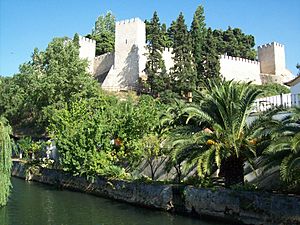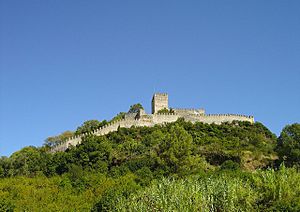Almohad campaign against Portugal (1190–1191) facts for kids
The Almohad Caliphate, a powerful empire from North Africa, launched a huge attack against the Kingdom of Portugal between spring 1190 and summer 1191. The Almohad leader, known as the Caliph Yaʿqūb al-Manṣūr, even crossed from Africa to lead his armies himself.
The first part of the war in 1190 didn't go as well as the Caliph hoped. This was mainly because Portugal received help from crusader armies passing through on their way to the Third Crusade. The Almohads had to give up their sieges (long military blockades) of important castles like Tomar, Santarém, and Silves. However, the Caliph decided to stay in Seville for the winter to plan his next moves.
The 1191 campaign was much more successful for the Almohads. They managed to take back areas Portugal had recently gained in the reconquista (the Christian reconquest of the Iberian Peninsula). They captured Silves after a second siege and pushed the border north towards the Tagus river.
Contents
The Almohad War in Portugal (1190-1191)
The First Attack: 1190 Campaign
Getting Ready for Battle
Caliph Yaʿqūb al-Manṣūr spent most of 1188 and 1189 getting ready for his big attack on Portugal. Before his invasion, in September 1189, the city of Silves had been captured by King Sancho I of Portugal. He got help from some crusaders who were sailing to join the siege of Acre in the Middle East.
In April 1190, Caliph al-Manṣūr finally began his invasion. Historical records mention that around this time, the Caliph defeated a fleet of northern crusaders near the Strait of Gibraltar. He captured many of them and was praised for his victory.
Al-Manṣūr's Plan
Once in al-Andalus (the Muslim-controlled parts of Iberia), the Caliph's army grew with soldiers from Seville and Granada. In June, he started a siege of Silves. By July, the Almohad navy joined the siege, making it even stronger. However, the Caliph decided to leave the siege of Silves to his local commanders. He took most of his main army to Córdoba.
In Córdoba, the Caliph met with representatives from King Alfonso VIII of Castile. They signed a truce (a temporary peace agreement). This allowed al-Manṣūr to focus all his efforts on Portugal. From Córdoba, he launched an attack into the Alentejo region of Portugal. The town of Torres Novas quickly surrendered. Its defenders were allowed to leave freely, but the town itself was completely destroyed. The Caliph then marched towards Tomar, a castle owned by the brave Knights Templar. His main goal, however, was to capture Santarém.
Crusaders Arrive to Help Portugal
At this crucial moment, two groups of crusaders arrived in Portugal by sea. At Silves, a single ship carrying about 100 English crusaders arrived amidst the chaos of the siege. Bishop Nicholas of Silves begged them to help defend the city. The citizens even sank the crusaders' ship to make sure they stayed! After being promised a new ship, the English crusaders agreed to join the defense.
The other nine ships of their fleet landed in Lisbon. This happened just as King Sancho was getting ready to march and defend Santarém. According to a historian, 500 crusaders agreed to join the King. With their arrival, King Sancho felt strong enough to refuse al-Manṣūr's offer of a seven-year truce, which would have meant giving up Silves. The King took up a defensive position in Santarém, which then came under siege.
Facing much stronger resistance than he expected, the Caliph decided to give up on Tomar and Santarém and retreated south. The siege of Tomar had only lasted five days. As they retreated, Torres Novas was burned down.
Meanwhile, while King Sancho and the 500 crusaders were marching south, another 63 English ships arrived in Lisbon. Unfortunately, fighting broke out between the crusaders and the city's Jewish and Muslim residents. King Sancho had to return to Lisbon to restore order. But within a few days, new riots started. About 700 crusaders were arrested, and their ships left Lisbon on July 24th.
After falling ill, Caliph al-Manṣūr decided to end the siege of Silves. His attackers were also running low on supplies. He retreated with his army to Seville, where he spent the winter.
The Second Attack: 1191 Campaign
Capturing Key Fortresses
In April 1191, Caliph al-Manṣūr launched his second attempt to take back Silves. He first tried to capture Alcácer do Sal by force, but then settled into a siege. The defenders soon surrendered on agreed terms and were allowed to leave freely. Unlike Torres Novas, which he had destroyed, al-Manṣūr decided to keep Alcácer do Sal and put a military force there. The Caliph even set aside money to help maintain the fortress.
After Alcácer do Sal, the towns of Palmela, Coina, and Almada were quickly captured. The castle of Leiria was destroyed, and the Almohads raided as far north as the areas around Coimbra. The castle of Alvor, whose people had been tragically killed in 1189, was also retaken.
The Fall of Silves (Again!)
For his second siege of Silves, al-Manṣūr brought four times as many siege engines (large machines used to attack castles) as the defenders had. In late June, he launched a major assault on Silves and managed to break through the walls. The defenders retreated into the citadel (the strongest part of the castle) and were besieged there. With King Sancho's permission, they surrendered on July 25th and were allowed to leave.
After signing a five-year truce with King Sancho, Caliph al-Manṣūr returned to Africa. He had successfully pushed the border north all the way to the Tagus river, leaving Portugal with only one important fortress south of that river, at Évora.
What Changed After the War?
Silves was later attacked and partly destroyed by the German Crusade of 1197. However, it remained under Almohad control for some time after these campaigns.




